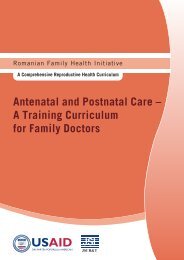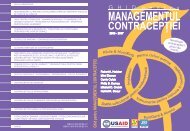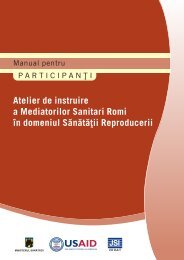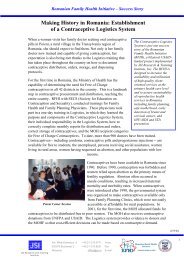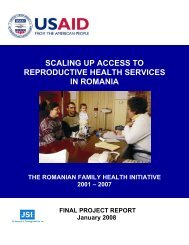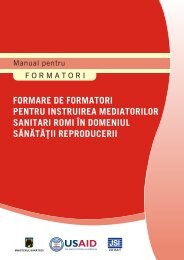Training of Roma Health Mediators in Reproductive Health
Training of Roma Health Mediators in Reproductive Health
Training of Roma Health Mediators in Reproductive Health
Create successful ePaper yourself
Turn your PDF publications into a flip-book with our unique Google optimized e-Paper software.
Participant document<br />
Sore or Cracked Nipples<br />
COMMON PROBLEMS DURING BREASTFEEDING<br />
Sore or cracked nipples develop when the baby sucks only the nipple <strong>in</strong>stead <strong>of</strong> tak<strong>in</strong>g<br />
the nipple and part <strong>of</strong> the breast when he is breastfeed<strong>in</strong>g.<br />
Recommendations:<br />
It is important to keep breastfeed<strong>in</strong>g the baby even if it hurts. To avoid sore nipples,<br />
breast feed <strong>of</strong>ten, for as long as the baby wants to suck, and be sure the baby is tak<strong>in</strong>g as<br />
much <strong>of</strong> the breast <strong>in</strong>to his mouth as he can. It also helps to change the baby's position<br />
each time he nurses.<br />
If only one nipple is sore, let the baby suck on the other side first, then let the baby suck<br />
from the sore nipple. After the baby is f<strong>in</strong>ished, squeeze out a little milk and rub the milk<br />
over the sore nipple. Let the milk dry before cover<strong>in</strong>g the nipple. The milk will help the<br />
nipple heal. If the nipple oozes a lot <strong>of</strong> blood or pus, milk the breast by hand until the<br />
nipple is healed.<br />
Breast Engorgement<br />
Breast engorgement occurs when the breasts are overfull, partly with milk and partly with<br />
<strong>in</strong>creased tissue fluid and blood, which <strong>in</strong>terferes with the flow <strong>of</strong> milk. Engorged breasts<br />
are very pa<strong>in</strong>ful, edematous, tight (especially the nipple), sh<strong>in</strong>y, and may look red; milk is<br />
NOT flow<strong>in</strong>g; and the woman may have a fever for 24 hours.<br />
Recommendations:<br />
• It is essential to remove milk from the breasts, otherwise mastitis will develop, an<br />
abscess may form, and milk production will decrease. Do NOT “rest” the breast.<br />
• If the baby is able to suckle, feed frequently, help<strong>in</strong>g the baby with position<strong>in</strong>g.<br />
• If the baby is not able to suckle, express milk by hand or by pump. Sometimes<br />
express<strong>in</strong>g a little milk will s<strong>of</strong>ten the breast enough so that baby can suckle.<br />
• Before feed<strong>in</strong>g:<br />
- Put warm compresses on the breast or take a warm shower<br />
- Massage the neck and back<br />
- Lightly massage the breast<br />
- Stimulate the nipple sk<strong>in</strong><br />
- Relax<br />
• To reduce edema after breastfeed<strong>in</strong>g, put cold compress on the breasts.<br />
Pa<strong>in</strong>ful Breasts<br />
Pa<strong>in</strong> <strong>in</strong> the breast can be caused by a sore nipple or by breasts that get very full and hard.<br />
The pa<strong>in</strong> will <strong>of</strong>ten go away <strong>in</strong> a day or two if the baby breastfeeds frequently and the<br />
mother rests <strong>in</strong> bed and dr<strong>in</strong>ks lots <strong>of</strong> liquids. Usually, no medication is needed but it is<br />
recommended for the woman to see the doctor.<br />
157<br />
RFHI/JSI <strong>Roma</strong>nia <strong>Tra<strong>in</strong><strong>in</strong>g</strong> <strong>of</strong> RHMs <strong>in</strong> <strong>Reproductive</strong> <strong>Health</strong> Session 9: Breastfeed<strong>in</strong>g



